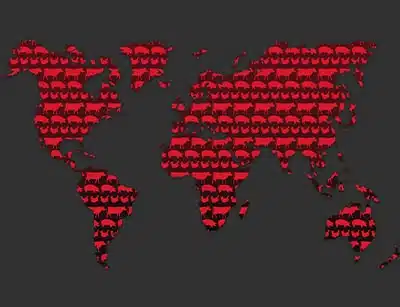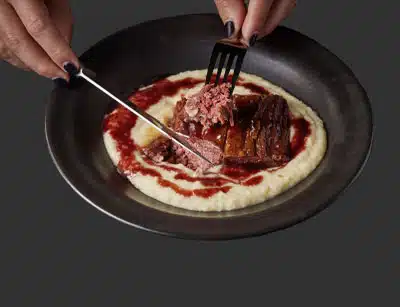
Cow Meat Diagram: Understanding Primal and Subprimal Cuts
The Basics
Meat from a cow is split into large sections known as primal beef cuts. Within each primal cut there are subprimals, which are then broken down into the cuts of beef we’re more familiar with in food retail; various types of steaks and roasts, etc.
Not all beef is made equal as its characteristics depend on which part of the cow it comes from. For example, the most tender beef cuts, such as beef ribs and tenderloin steak, are the furthest cuts from the cow’s horn and hoof. Whereas the toughest cuts of beef are found where the well-exercised muscles are, such as the shoulder, legs and pectoral muscles.
The front of the cow is called the forequarter, and the back of the cow is called the hindquarter. We’ll break down each cut into forequarter and hindquarter cuts.
Forequarter Cuts of Beef
Forequarter cuts of beef include the rib, plate, chuck, shank and brisket. Let’s take a closer look at each of them.
Beef Rib
Beef ribs are larger in size than pork ribs and tend to have more meat on the bones. They also tend to be more marbled from the higher fat content, which helps add to the meat’s tenderness and flavor. They have lots of connective tissue that needs attention when preparing the beef ribs to ensure a pleasurable eating experience.

A cow has thirteen pairs of ribs, stretching from the breastbone to the backbone and from the shoulder to the last rib. The ribs from different parts of the body have different characteristics in terms of taste and texture.
Traditionally, only the meat from the last six cow ribs are what we refer to as “beef ribs”. The two main types of beef ribs are “short ribs” and “back ribs”. Although both are usually tender, they differ in many ways.
Interestingly, it’s not just short ribs and back ribs that come from the beef rib primal cut. So too do the incredibly popular ribeye steak and more classical French entrecote steak. They are both known for their tenderness and versatility.
Short Ribs
Short ribs have a large amount of meat on the top of the bones, making them ideal for outdoor grilling. The bone itself is almost flat. They can reach up to twelve inches long and have up to two inches of meat on top.
Back Ribs
Back ribs are used for rib roast (prime rib) removed from the bones. It’s one of the most expensive cuts of beef you can get. Most of the meat is found between the rib bones, and they come in smaller than short ribs as they are usually between six to eight inches long. The bones are curved as opposed to the flat bones of short ribs.
Beef Plate
Beef plate is found just below the ribs (it actually includes the bottom ribs) and has a lot of cartilage and fat. The fat makes it a great option for ground beef. Skirt steak comes from the beef plate, which is the tasty meat favored in carne asada. It’s a thin cut of meat which allows it to cook quickly.

Beef Chuck
Chuck steak often contains part of a cow’s shoulder bones, which is why it has been given the name “7-bone steak”. The bone-in steak offers some of the best value for money when it comes to beef. It’s popularly used in ground beef because it has a strong flavor and good balance between the meat and fat.
Like brisket and shank, beef chuck comes from well-exercised parts of the cow (the shoulders) that have lots of connective tissue, thus leaving a tough and chewy cut of meat. However, beef chuck does still have relatively high levels of fat, which helps elevate its strong flavor when cooking.
The best way to cook beef chuck is to braise it, such as in a beef stew or beef pot roast, which is definitely the most popular method.
Traditionally, butchers didn’t know what to do with the chuck beyond selling it in big roast pieces ideal for braising. They then began to turn it into ground beef because its relatively high fat content creates tasty, juicy burgers. However, that didn’t bring much profit as ground beef is one of the cheapest ways to sell meat. So, they began to work out ways to find particular parts of the chuck that could be turned into more premium steaks. Now, the infamous flat iron steak and Denver steak come from the chuck.

Beef Shank
The shank cut of beef is a lean cut, which means it lends itself to slow-cooking to tenderize it. It’s lean because it comes from the legs of a cow, which is a muscle that is constantly used. Due to the tough nature of beef shank, it is not the most popular cut of beef. It’s found mostly in beef stocks and soups because it is cheap and these dishes do not require the best quality beef.

Beef Brisket
Brisket comes from a cow’s lower breasts or pectoral muscles, which are well-exercised parts of the cow and support most of a cow’s weight. That means brisket is relatively tough with lots of connective tissue (it’s one of the least tender cuts of beef), hence why it’s become synonymous with slow-cooking. Cooking it low and slow means you can still achieve a soft, tender end result with brisket.
Brisket is inexpensive and boneless and is often large in size, weighing up to eight pounds.
Given the most common cooking method for preparing brisket is low and slow, it usually adopts its tastes from cooking. It may be brined or smoked, which imbues it with very particular flavors, or it may be braised in a liquid through which the aromatics will infuse the meat.
Brisket is usually split into two pieces and sold as either a “first cut” or “second cut”. The first cut is flat, thin and leaner. It is easier to slice neatly and has a more attractive quality. The second cut is fattier and therefore has more flavor. The fat helps make a more delicious stew as the brisket braises.

Hindquarter Cuts of Beef
Hindquarter cuts of beef include the sirloin, tenderloin, flank, and round. We cover the details of each below.
Beef Sirloin
Sirloin steaks tend to be bold in flavor and have a good marbling effect. They are cut from the hip area of a cow. There are actually numerous types of steak that fit into the sirloin category: top sirloin (the best quality and most expensive) and sirloin steak (less tender and better for roasting or barbecuing).

Beef Tenderloin
This is known to be the most tender cut of beef on the cow – it’s where Filet Mignon comes from. It runs from the short loin into the sirloin. The best way to cook beef tenderloin is with dry-heat, e.g. grilling, and to avoid lengthy exposure to heat. Since it’s so tender, it doesn’t require a long time to cook. The quicker it’s cooked and the higher the temperature the better.
Redefine Tenderloin is a smooth and premium cut of new-meat that provides the ultimate gastronomic experience – with just the right gradations in color, texture, taste, and mouthfeel. You can have a great meat-eating experience whether you’re a meat lover or vegan, without compromising on taste or sustainability.

Beef Flank
A flank steak is a long, flat, grainy cut of steak that is known for its chewiness. The grain comes from fibers in the meat, which is common in well-exercised parts of the cow, including the flank (which comes from the abdominal muscles).

Since it comes from the abdominal muscles, flank steak is a particularly lean cut of meat and has almost no fat. The grain makes the meat tougher than other cuts, which means flank steak is often used in dishes where it requires a marinade to tenderize it, such as stir-fries, stews, and fajitas.

For all of these reasons, beef flank was one of the first cuts of meat we had in mind when creating our Premium Cuts portfolio. Redefine Beef Flank, which has up to 26 g of protein per 100 g and low amounts of fat, including saturated fat. Moreover, it’s rich in flavor and lends itself to a variety of different cooking methods. You can find some of our favorite recipes for Redefine Flank here.

Beef Round
Beef from the round makes for a lean cut, that’s relatively tough compared to others. It comes from the back leg of the steer which gets a lot of exercise. There are a number of different subprimal cuts that come from the beef round, including the top round, bottom round, and knuckle. If you’re familiar with a rump roast, this comes from the bottom round.
Without much collagen present in the lean beef round cuts, they’re not recommended for braising, which benefits from the collagen for its gelatinous texture and flavor. Instead, the round is better roasted until medium rare, after which it’s best to thinly slice it against the grain.

Wrapping Up
Each different part of the cow has its own characteristics when it comes to the cuts of beef it produces. While some are more tender and can be dry-cooked quickly, such as the tenderloin, others come from more exercised areas and are therefore leaner and better suited to slow-cooking, such as the brisket. And if you’re looking for ways to enjoy delicious tasting, tender beef without compromising on sustainability, then new-meat has you covered.





